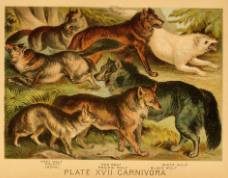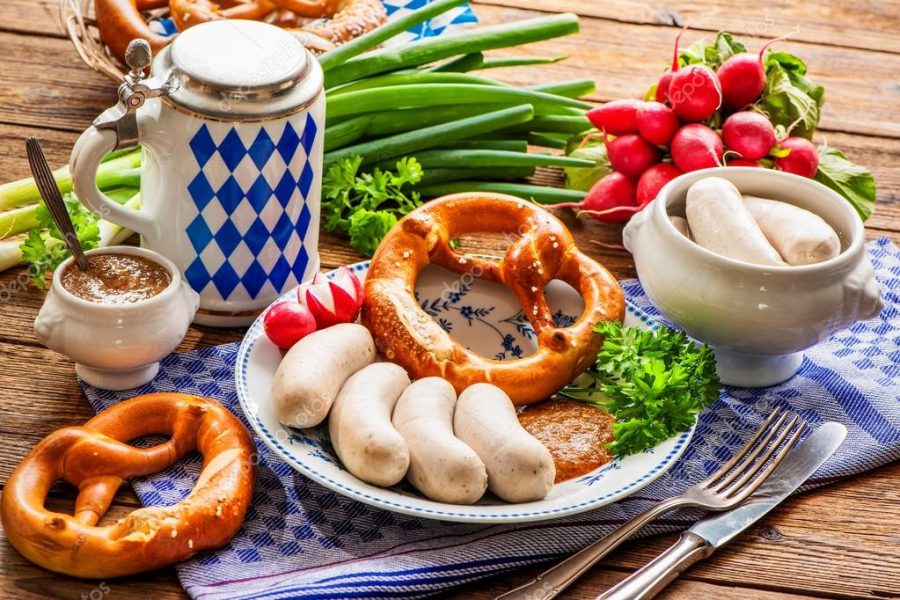Food and Eating Habits of the Germans
(Image via Deposit Photos)
February 22, 2020
Germans are known for their traditional food around the world. What many people don’t know is the fact that German food is so much more than sausage or Sauerkraut. Depending on where in Germany you stay, you will find a big variety of traditional food. Of course, you can also find food from different countries and some traditional German food you can find german wide.
The southern region shares many specialties that reach over to Austria or Switzerland. To give an example Kässpätzle, also called Käsknöpfle or Kässpatzn, is hot spätzle with grated granular cheese, usually Emmental cheese. Another specialty is Kaiserschmarrn, a light, caramelized pancake. According to a legend, the empress Sissi had to stay in a certain thin figure and only ate less Schmarrn, whereupon the emperor said, “Give me this Schmarrn that our Leopold has cooked again.” A typical Bavarian specialty is Weißwurst, a sausage with a mild taste and a firm, bouncy bite. Their history goes back to the 1800s. Weißwürste are usually handed out in pairs, along with a Bretzl, a dollop of sweet mustard, and a glass of Weizenbier (wheat beer).
In the Northern states, seafood abounds, but there are also famous meat dishes like Koenigsberger Klopse, which are meatballs in white sauce. It began as a specialty from the once long-standing Prussian Empire 200 years ago and counts to one of the most famous German dishes. Another dish more known in the northern part of Germany is Gruenkohl with Pinkel, a combination of kale and a variety of sausages and/or meat. It is often served with Pinkel, which is smoked Kaszanka, a type of sausage.
Some traditional food got so famous that everybody in Germany knows them, for example, Döner. Modern fast food was invented by a Turkish immigrant in 1971 in Berlin. However, Döner is made of meat, lettuce, tomato, onions, and cucumber. Another also pretty famous sausage is Currywurst. Currywurst, a sausage, typically cut in bite-sized chunks and served with curry ketchup, itself topped with curry powder, was invented after the second world war in Berlin.
Moreover, soups play an important role in the German menu. Light soups as a starter, or hearty soups and stews as the main dish. Also, an important role in German cuisine is salads. Light salads like lettuce, tomatoes, and cucumbers often accompany a meat dish. But Germans also have filling salads such as noodle salad, potato salad, and dumpling salad. A must-have of every full menu is a dessert. It can be a cake, cupcakes, pudding or just something little.
Following this German advice “Eat breakfast like an emperor, lunch like a king and dinner like a beggar,” it would be healthier for yourself, although it is hardly manageable in real life.
In real life, people have only a light breakfast. Cereals, a slice of bread with jam, cheese or cold cuts. Students and people at work often have the chance for a quick snack around 10 am. But it is mostly different on weekends or holidays. Full breakfast at hotels, and home, includes bread rolls, toast, sausages and cold cuts, cheese, boiled and fried eggs, muesli, and cereals. For lunch, most people love to have their main meal of the day at lunchtime! A traditional German Mittagessen consists of a light soup, meat, vegetables and potatoes or rice as the main course, and a delicious dessert. At many restaurants, you’ll find the “Stammessen” or “Tagesgericht” on the menu at lunchtime. This is a three-course meal at a special price that changes daily. “Kaffee” is a break sometime between lunch and dinner, to enjoy a cup of coffee and a piece of cake, or cookies. In these busy times, we won’t have a “Kaffee break” during the week, especially not while at work or school. However, on Sundays and public holidays, having “Kaffee” is still an important tradition. For birthdays and other celebrations, or just hanging out with friends or family, you are often invited “Zum Kaffee”. The traditional German dinner consists of bread or toast, cold cuts, cheese, salads, pickled vegetables, canned fish, or even leftovers from lunch. However, many Germans have a warm meal for dinner, especially when they don’t have a warm meal for lunch. In restaurants, you find a wide range of cold specialties like Wurstsalat, cheese varieties, sausages and more. There is often a separate menu called “Brotzeitkarte”. Items on these menus are also available during the day.
In conclusion, there are many great German specialties, you should try if you get the opportunity. Food as well as habits change over the years and depending on where you live and how and where you grew up, you probably have different cuisine.
Guten Appetit!











































































































































gwen woods • Feb 24, 2020 at 11:20 am
I really enjoyed this writing! I thought it was very interesting.
Anna Hansen • Feb 24, 2020 at 10:27 am
Your article is so good and interesting! I love it!
Morgan • Feb 24, 2020 at 10:24 am
I thought i was really interesting to learn about what people in other cultures eat and whats traditional for them. Some of this sounds really good and definitely different for here.
Ella • Feb 24, 2020 at 10:20 am
I actually really enjoyed reading this. It obviously had a lot of depth and opens up with some good facts. Keep up the amazing writing, and to be honest I may or may not take some nice tactics you used in the article to help improve mine.